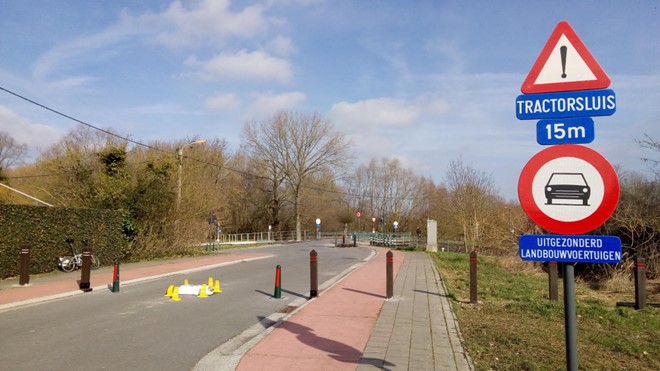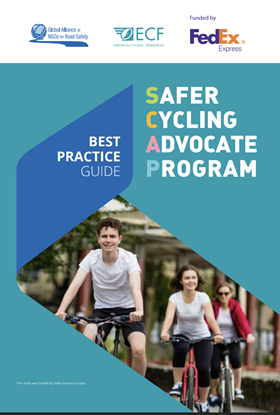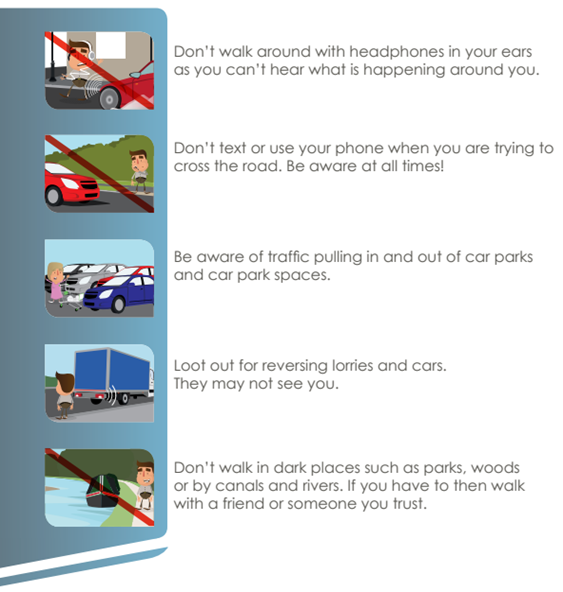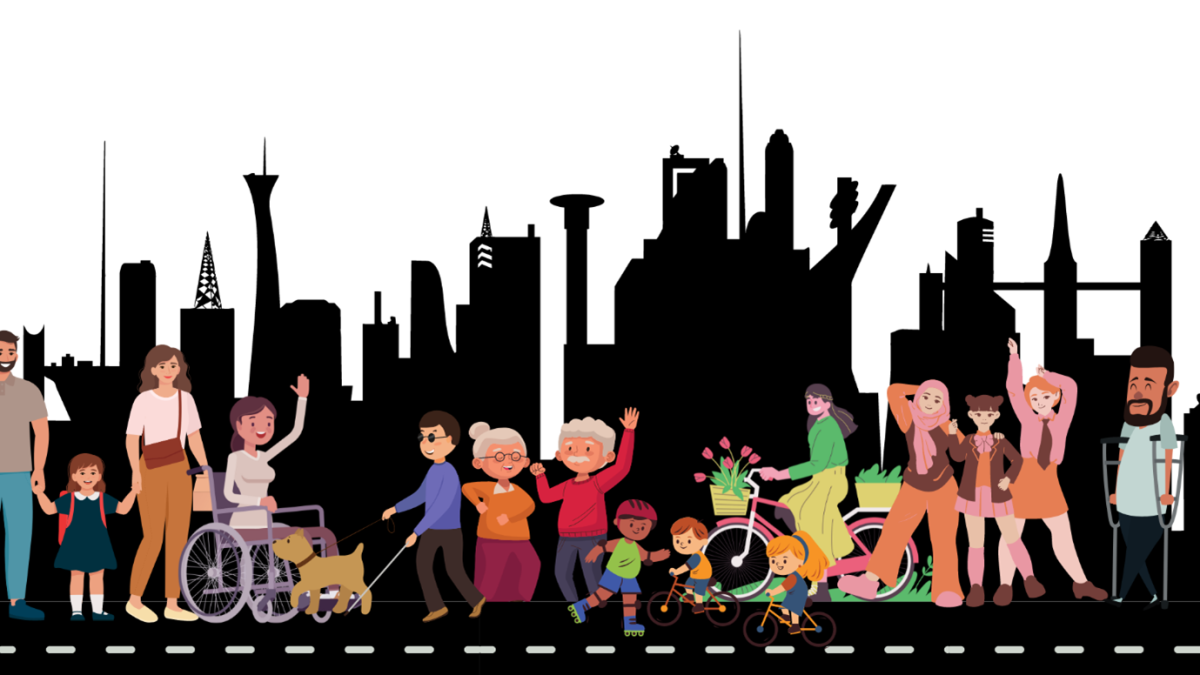The European Road Safety Charter aims to make the European roads safer for everyone. However, every road user has their challenges, and actions taken to improve the safety of one road user can increase the risk of danger for someone else. We must understand these different challenges and remind ourselves of them every time we implement an action. Our recent webinar, Road Safety for All aimed to help our members to succeed in this challenge. The webinar invited the following six experts:
- Isobel Duxfield, POLIS
- Karin Müller, Deutsche Verkehrswacht
- Aleksander Buczynski, ECF
- Valeria Motta, Global Alliance for NGOs for Road Safety
- Soufiane El Amrani, Inclusion Europe
- Antoine Fobe, EBU
Isobel Duxfield from Polis kicked off the webinar by highlighting the importance of understanding the impact of gender on travel patterns and experiences in safety and security on the road. A study from the UK revealed that 40% of women tend to avoid transit options out of fear of sexual harassment and a Catalonian study showed that nearly 65% of public transport users were once victims of unwanted sexual behaviour. Isobel emphasized that researchers should pay attention to gender (and sexuality, (dis)ability, race, age, and socio-economic status) when collecting data to take the differences into account when creating, implementing, and evaluating policies. Nevertheless, we should not describe women, and other types of road users, as vulnerable road users. This term can disempower them and overlook the fact that it is our current mobility infrastructure that places them in vulnerable situations.
The second presentation was given by Karin Müller from the Deutsche Verkehrswacht. She discussed how we can include the safety of elderly road users in our road safety actions. When we become older, we experience physical and mental changes that can challenge our mobility and movement patterns. Our physical and mental capacity can decrease, we are more prone to diseases, use more medication, and can suffer from daytime sleepiness. However, traffic remains the same and requires us to be able to react quickly and correctly in complex situations. In Germany, elderly road users make up for 36.8% of all road fatalities, while they only represent 21.6% of the total population. In 2022, of the 365 pedestrians killed, 208 of them were above the age of 65. These statistics demonstrate the importance of targeted awareness campaigns and actions to inform elderly road users on the different aspects of fitness to drive. Regular health checks, an active lifestyle, knowledge of the impact of certain medicines on driving skills, and regular practice can help to save lives. The Deutsche Verkehrswacht gave training on how to safely drive a car, bicycle, and speed pedelec. They also organised road safety days where elderly road users could receive free advice, do various tests on reflexes, hearing, and vision, drive a simulator, and witness the dangers of dead angles. The presentation highlighted the importance of clear and easily comprehensible infrastructure. Awareness action should be combined with safe paths and crossings that allow road users to travel safely together.
In the second presentation, the importance of staying active was already highlighted. Switching from a car to a bike or e-bike for your daily commute is a good example of a road safety measure that can also improve your health. The bike is becoming more popular in all European regions. In the North and West, the transport mode is mostly used in urban areas, while in Eastern Europe it is more used to move around in rural areas. The growing popularity of e-bikes makes cycling more accessible for parents, elderly road users, and people living in hilly areas. Aleksander Buczynski from the European Cyclists’ Federation (ECF) was invited to give some more details on safe cycling infrastructure, a key element in promoting cycling. The more cyclists on the road, the safer it becomes for individual cyclists. However, if cyclists are left out of road safety measures, it will have an impact on both the safety of the road users and the public health. Safe cycling infrastructure should be continuous, feel safe, avoid detours, interruptions, and vibrations, and minimize exposure to fast or heavy traffic and air pollution. Traffic circulation plans for cities with low-traffic neighborhoods, one-way streets, and camera surveillance are measurements that can help to improve the safety perception of cyclists in urban areas.

The Global Alliance of NGOs for Road Safety, represented by Valeria Motta in the webinar, developed a Safer Cycling Advocate Program (SCAP) to bring together people who wish to improve the safety of cyclists. Their guide collects examples of the best cycling policy and the latest research in four different areas: (1) infrastructure, (2) vehicle safety, (3) management, and (4) road user behaviour. Together with this guide, they organised capacity-building training for NGOs. These trainings gave the possibility to 115 NGOs from 9 different countries to discuss how the guide could be implemented in their own context and how they can better identify local issues and solutions, improve local infrastructure, and engage with policymakers.

Another important action in our road to Vision Zero is road safety education. Road safety for all means that we adapt our communication and education to all types of road users. One group that unfortunately still encounters many barriers is people with intellectual disabilities. When road safety education is tailored to their needs, they will receive more independence, be able to make their own mobility choices, know their rights on the street, and be able to take part in society in their own way. Soufiane El Amrani from Inclusion Europe gave some tips on how introducing easy-to-read resources in road safety education can help break down these barriers. The main tips were:
- Use words that are easy to understand. If you do need to use a specific word (e.g. micro-mobility or speed pedelecs), explain this word
- Use the same word for the same thing throughout the text
- Keep sentences short and only say one thing per sentence
- Use full names and avoid abbreviations or pronouns
- Avoid words in other languages
- Write numbers in digits
- Use pictures

The last presentation was given by Antoine Fobe from the European Blind Union (EBU). In his presentation, he mentioned current and future challenges for vision-impaired road users. One of these challenges is low-noise vehicles that are nearly impossible to detect only by hearing. Since 2019, all new types of such vehicles need to be equipped with an Acoustic Vehicle Alert System (AVAS), but cars built before 2019, motorcycles and scooters still drive around with the application. The AVAS is also only automatically activated until 20km/h, while the EBU recommends adapting this to 30km/h. In the future, AVAS should be uniform, easily recognizable, and offer a clear perception of acceleration and deceleration.
Another mobility trend that tends to exclude vision-impaired road users is the use of shared spaces. This concept currently includes the absence of conventional design features used by blind and partially sighted people as orientation aids, such as pavements with kerbs, traffic signs, and traffic signals. It also deprives them of feeling safe as cyclists and scooters pass them by at often high speed or leave their bike or scooter on the pavement. The concept of shared space is developed with the assumption that different road users communicate with each other via eye contact, an assumption that automatically excludes road users.
This recent event provided vital insights for our members to understand the challenges facing road users and strategies to start making improvements so that ALL road users feel safe. Thank you to our fantastic speakers for their time and knowledge.
Watch the recording of this event here
If you would like to be involved in future events then sign up to become a member and join our growing road safety community here.
